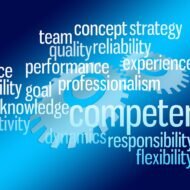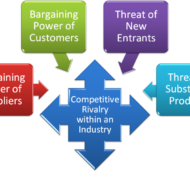Posted by Managementguru in Video Lecturers
on Apr 20th, 2014 | 0 comments

Strategic Management Video Lecture by David Kryscynski This is the introduction lecture for Strategic Management. Very Innovative and Informative video. A List of Strategic Management Terms Business – A strategy that pertains to single departments or units within a company.Combination – A type of grand strategy that employs several different grand strategies at once.Concentration – A growth strategy that extends the sale of current products or services to a company’s current market.Differentiation – A business strategy that strives to make the company’s product or service unique.Diversification – A growth strategy that moves a company into a similar kind of business with new or different products or services.Divestiture – A type of defensive strategy in which a company sells some part of its business, often an unprofitable part.Evaluating – The process of continuously monitoring the company’s progress toward its long-range goals and mission.Focus – A business strategy that directs marketing and sales towards a small segment of the market.Formal – The type of planning that involves systematic studying of an issue and the preparation of a written document to deal with the problem.Formulating strategy – Developing the grand- and business-level strategies to be used by the company.Functional – A strategy which involves short-range operational plans which support business strategies by emphasizing practical implementation.Goal – A concise statement that provides direction for employees and set standards for achieving the company’s strategic planGrand – A type of strategy that provides overall direction for the company.Growth – A type of grand strategy developed when a company tries to expand sales, products, or number of employees.Implementing – Putting a strategy to work after it has been formulated.Intermediate – Covers the time span between short-range and long-range, usually 1-3 years or 1-5 yearsLiquidation – A type of defensive strategy in which the entire company is sold or dissolved.Long Term– A three-to-five year period of time, but possibly as far as 20 years into the future.Mission Statement – A brief summary explaining why a company exists.Operational – Short-range planning that focuses on forming ideas for dealing with specific functions in the company.Overall Cost Leadership – A business strategy that is designed to produce and deliver a product or service for a lower cost than the competition.Planning – The process that businesses use to decide the company’s goals for the future and the ways to achieve those goals.Policy – A broad general guide to action that establishes boundaries within which employees must operate.Procedure – A detailed series of related steps of tasks written to implement a policy.Retrenchment – A type of strategy that aims to reverse negative trends in a company, such as losses in sales.Rule – A specific and definite corporate action that employees must follow.Short Term– A one-year period of time.Stability – A type of strategy that aims to keep the company operating at the same level that it has for several years.Strategic – Long-range planning done by the highest management levels in the company.Strategic Management – The application of the basic planning process at the highest levels of the company.Strategy – An outline of the basic steps management is going to take to achieve a goal.SWOT Analysis – The most utilized process for determining a company’s overall health; it involves analyzing internal strengths, internal weaknesses, external opportunities, and external threats.Turnaround – A type of defensive strategy that is used to regain success.Vertical Integration – A growth strategy that moves a company into a market it previously served either as a supplier or as a customer. Take The Test to Check Your Strategic...

Posted by Managementguru in Business Management, Marketing, Organisational behaviour, Principles of Management, Strategy
on Mar 22nd, 2014 | 0 comments

PORTER’S FIVE FORCES Porter’s five forces analysis-draws upon industrial organization (IO) economics to derive five forces that determine the competitive intensity and therefore attractiveness of a market. Survival of the Fittest: True to Darwin’s theory “Survival of the fittest”, only competitive firms survive in the business market, provided, they have made the right strategic choice by comprehensively analyzing their position in the industry. Every organization is part of the industry and almost all of them face competition. Thus, industry and competition are the vital considerations for making a strategic choice. All the firms in a particular industry vie for the same set of customers by offering identical or similar products with minor variations. The analysis of the external environment in relation to the context of industry attractiveness thus becomes essential. A Critical Evaluation of Michael Porter’s Five Forces Framework Industrial Analysis: Industry analysis helps a firm to also fix long range plans, by gauging long term growth opportunities present if any. Strategic choice is nothing but, to screen all possible strategic alternatives followed by narrowing down the choice to the best suited and feasible alternatives and ultimately choosing an optimum strategy. To explain it in more clear terms, let us look at this example. Say, if there are three big players of car manufacturers in an automobile industry. Each follows their own strategic style to capture the market. What are the threat factors? Threat can be in the form of four-wheeler manufacturers like trucks and jeeps, but these cannot be competitively priced. Threat can be in the form of suppliers who dominate the industry by having a grip on the supply of components, sub-assemblies and accessories. Threat in the form of new entrants, but the growth might be restricted due to government regulations. A thorough analysis of the automobile industry thus made can make things clear to the firm, as to where they stand in terms of market share, what are their strengths and weaknesses, who pose a threat, what are the potential opportunities for growth and to tap market segments whose needs are unidentified. Still, it will be a seller’s market where the buyers have no bargaining power. On the other hand, if the weather does not favor its growth, the firm has to immediately decide on its next course of action, calling for diversification. The possible threats for a firm can come from five directions as mentioned below: Potential threat from new firms entering the market Threat from substitutes available in the market Threat from competitors Bargaining power of the suppliers Bargaining power of the buyers The structure and dynamics of an industry has to be analyzed in order to determine the intensity of competition and profitability. As the market is very dynamic, it becomes mandatory for firms to evolve strategies embracing a modern approach, with emphasis on reappraisal of existing strategy in the light of changing external conditions and formulation of alternative...

Posted by Managementguru in Business Management, Decision Making, Leadership, Startups, Strategy
on Feb 19th, 2014 | 0 comments

Effective Strategy Generation Why effective strategy generation is necessary? A business enterprise has to generate strategic alternatives and determine the effectiveness of its strategic decisions in order to be successful in the market. Various approaches to strategy formulations exist and it is a real complex phenomenon in that, a wrong strategic execution may produce irreparable consequences which may prove detrimental to the survival of the firm. The method of strategy formation usually follows the traditional approach, based on rational and normative disposition. Sometimes different thought processes may also serve as basic premises for the evolution of new strategies. Intuition: The strategy evolves in the mind of the chief executive without ever being explicitly stated and without the aid of formal procedures. Personal judgment also backs up this process. People with excellent intuition are often remembered for their imagination, drive and expansive vision leading to corporate growth and prosperity. To look into the future with such creativity and brilliance is the basic premise of this approach. Disjointed Incrementalism: This approach towards strategy making reflects an attitude of management having strong preference to act only when there is a need or only when forced to, and then considering a few convenient alternatives involving only small, non-disruptive changes in the organization. This approach is followed by firms that enjoy a pretty decent profit margin in the existing business and possess an exclusive niche in the market; they will not be ready to come out of their cocoons for fear of failure. The firm cannot take the risk of setting unrealistic goals deviating away from the status quo. Pic Courtesy: Account Manager Tips Entrepreneurial Approach: Systematic risk-makers and takers who look for and find opportunities belong to this category. Entrepreneurs view challenges as opportunities and not as problems. Key factor approach: This approach is based on determining the really significant factors that are important in the success of a particular business and concentrating major decisions on it. Say, for instance, a quality product at relatively low price may be a critical factor for a business firm. But eventually it has to achieve this in order to capture the market whence the same critical factor becomes unique to the company and adds value. Integrated approach: Analyzing the present internal and external conditions Identifying and evaluating the present strategy Search for strength and weaknesses viewed within the present strategy and environment Considering changes in the present strategy Generating alternatives unified to resolve the problems and exploit the opportunities Developing alternative unified strategies by combining the various alternatives in each of the problem and opportunity area Evaluation of unified strategy in terms of the enterprise objectives and choosing the strategy that best satisfies the objectives. Strategy formations should conform and comply with the changes in the external environment and the change called for may be in the strategy itself or in the implementation of the...






